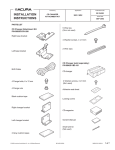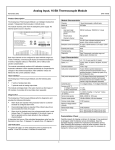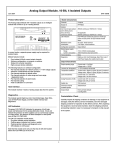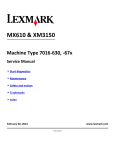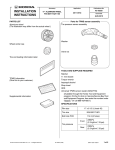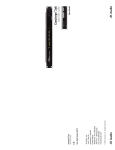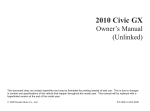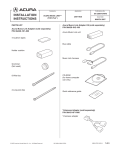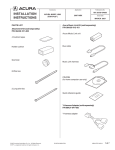Download 2012 - Bernardi Parts
Transcript
Accessory INSTALLATION INSTRUCTIONS Application Publications No. BII 46117 19” ALUMINUM WHEEL 2012 RDX Issue Date AUG 2011 PARTS LIST Parts for TPMS sensor assembly Tire pressure sensor assembly Aluminum wheel (The illustration may differ from the actual wheel.) Washer Wheel center cap (The illustration may differ from the actual center cap.) Valve cap Valve nut Center cap emblem TOOLS AND SUPPLIES REQUIRED 2 Push nuts Ratchet 11 mm Socket Torque wrench Isopropyl alcohol Tire pressure information label Shop towel SPECIFICATIONS Important information Wheel cleaning information (Give this information to your client.) Rim size 19 x 8 J (offset 45) Tire size 245/45R19 98Y Bolt hole PCD 114.3 (5 holes) Front 33 psi (230 kPa, 2.3 kgf/cm2) Rear 33 psi (230 kPa, 2.3 kgf/cm2) Tire pressure TPMS information (Give this information to your client.) © 2011 American Honda Motor Co., Inc. - All Rights Reserved. BII 46117 (1108) 08W19-STK-2000-91 1 of 6 INSTALLATION 2. Client Information: The information in this installation instruction is intended for use only by skilled technicians who have the proper tools, equipment, and training to correctly and safely add equipment to your vehicle. These procedures should not be attempted by “do-it-yourselfers.” Install the tire pressure sensor to the aluminum wheel and loosely install the valve nut. Make sure the pressure sensor is resting on the wheel. WASHER VALVE NUT NOTE: • • This aluminum wheel is designed for use on vehicles equipped with TPMS (Tire Pressure Monitoring System). GROMMET VALVE STEM This aluminum wheel is equipped with a TPMS sensor. See the service manual for the tire replacement procedure and TPMS sensor installation procedure. Do not allow the tire pressure sensor to rotate as you torque the valve nut. • Install the correct size tire (245/45R19 98Y). • The wheel nut torque is 108 N·m (80 lb-ft). • Be careful not to damage the wheel center cap when installing the emblem. • The center cap emblem kit should be installed only if the ambient air temperature is 60°F (15°C) or above. • To allow the adhesive to cure, do not wash the vehicle for 24 hours. 1. Before installing the tire pressure sensor, clean the mating surface on the sensor and the aluminum wheel. WASHER TIRE PRESSURE SENSOR WHEEL CENTER VALVE NUT Torque: 4 N·m (36 in-lb) ALUMINUM WHEEL 3. 6324010Y Torque the valve nut to 4 N·m (36 in-lb) while holding the tire pressure sensor toward the wheel. You may hear a snap or pop as you tighten the nut–this is normal. NOTE: • Do not reuse a grommet that has already been torqued. If you do, the valve stem may leak. • Do not use pneumatic or electric tools on the valve nut. • Tightening the nut above the specified torque can damage the grommet. • Make sure that there is no gap between the sensor and the wheel. 4. 2 of 6 OUTSIDE BII 46117 (1108) Install the tires according to the procedure in the service manual. Be careful not to damage the new sensor. © 2011 American Honda Motor Co., Inc. - All Rights Reserved. 5. 6. Using isopropyl alcohol on a shop towel, clean the area where the center cap emblem will attach. Remove the adhesive backing from the center cap emblem. WHEEL CENTER CAP 10. Open the driver’s door. Using isopropyl alcohol, clean the tire pressure information label on the doorjamb. Remove the adhesive backing from the new information label and attach it over the old label. 10-DIGIT NUMBER PUSH NUTS ADHESIVE BACKING TIRE PRESSURE INFORMATION LABEL PUSH NUT (Note the direction of the push nuts.) NEW TIRE PRESSURE INFORMATION LABEL CENTER CAP EMBLEM CENTER CAP EMBLEM WHEEL CENTER CAP CURRENT TIRE INFORMATION LABEL 2N07041W 6324020Y 7. Attach the center cap emblem to the wheel center cap by aligning its pins with the holes in the wheel center cap. After attaching, hold the emblem firmly against the wheel center cap with the palm of your hand for 30 seconds. 8. Slide the push nuts onto the pins. Note the direction of the push nuts. 9. Install the cap onto the wheel. © 2011 American Honda Motor Co., Inc. - All Rights Reserved. 11. Install the wheels on the vehicle and torque them to 108 N·m (80 lb-ft). Put the valve stems at the 12 o'clock position before lowering the vehicle to the ground. 12. Do the sensor ID learning procedure (see page 4). BII 46117 (1108) 3 of 6 SENSOR ID LEARNING NOTE: To ensure that the control unit memorizes the correct IDs, park the vehicle with the new sensors at least 3 m (10 ft) from any other TPMS pressure sensor not installed on that vehicle. 13. Connect the HDS to the vehicle, make sure the correct VIN is populated, and enter the mileage. 14. At the System Selection Menu, click TPMS. 15. At the Mode Menu, click DTC and clear any stored codes. 16. Go back to the Mode Menu, click Sensor ID Learning and follow the screen prompts. NOTE: If the sensor ID learning fails, have an assistant drive the vehicle under 10 mph while you redo the ID learning procedure. The TPMS control unit should learn all four sensor IDs. If one or more of the sensor IDs are not learned, then go to normal troubleshooting in the service manual before continuing. If all four sensor IDs are learned, go to step 17. LOW TIRE PRESSURE WARNING THRESHOLD REPROGRAMMING 17. From the TPMS Mode Menu, click on Threshold Rewriting. 18. Select “Reprogramming for accessory tires.” 19. When the HDS says "Do you want to rewrite the threshold data?" click “YES.” 20. When “Please enter the tire information code of new tires” is shown, click the Keyboard icon. 21. Enter the 10-digit tire information code printed on the new tire pressure information label, then click the check icon. 22. Check that the tire pressure shown on the HDS matches the one on the new tire pressure information label, then click the “YES” button. 23. Check that the current air pressure setting shown on the HDS is correct and “Reprogramming the threshold data for non-standard tires has completed successfully” is shown. 24. Write the tire pressure indicated on the HDS in the service history page for Acura Accessory Wheels, then click the check icon. TIRE PRESSURE INFORMATION LABEL DATA LINK CONNECTOR HDS 4 of 6 10-DIGIT CODE 6126021B BII 46117 (1107) © 2011 American Honda Motor Co., Inc. - All Rights Reserved. 25. Sign on the service history page for Acura Accessory Wheels, according to the procedure on page 5. 26. Write the tire size, tire pressure, HDS version, dealer name, technician's signature, and date in the service history page for Acura Accessory Wheels page, and attach the page to the vehicle's service history booklet. NOTE: Explain the changes made in the service history booklet to your client before delivering the vehicle. Be sure to give the wheel cleaning information and TPMS information to your client. STANDARD TIRE PRESSURE PROGRAMMING If the original equipment (standard) wheels are reinstalled on the vehicle, the low pressure warning threshold must be restored to the factory setting. To return the TPMS programming from the inch-up wheel to the standard wheel, do the following: 1. Connect the HDS to the vehicle, make sure the correct VIN is populated, and enter the mileage. 2. At the System Selection Menu, click TPMS. 3. At the Mode Menu, click DTC and clear any stored codes. 4. Go back to the Mode Menu, click Threshold Rewriting. 5. Click on "Reprogramming for standard tires" and follow the screen prompts 6. After programming, write the measured tire pressure in the important information, then click the check button. 7. Attach the standard tire pressure information label over the old label in the driver's doorjamb. 8. After programming, sign the service history page for Acura Accessory Wheels. DATA LINK CONNECTOR 6126021B HDS © 2011 American Honda Motor Co., Inc. - All Rights Reserved. BII 46117 (1107) 5 of 6 THRESHOLD DATA CHECK If you are unsure of where the low pressure warning threshold is set, it can be checked by using Threshold Data Check. 1. Connect the HDS to the vehicle, make sure the correct VIN is populated, and enter the mileage. 2. At the System Selection Menu, click TPMS. 3. Click on Threshold Rewriting. 4. Click on Threshold Data Check. DATA LINK CONNECTOR 6126021B HDS TPMS UNIT REPLACEMENT If the TPMS control unit is replaced and the vehicle has inch-up wheels, the low pressure sensor threshold must be changed. Once the TPMS control unit is installed, redo sensor ID learning and low tire pressure warning threshold reprogramming (see page 4). 6 of 6 BII 46117 (1108) © 2011 American Honda Motor Co., Inc. - All Rights Reserved.







